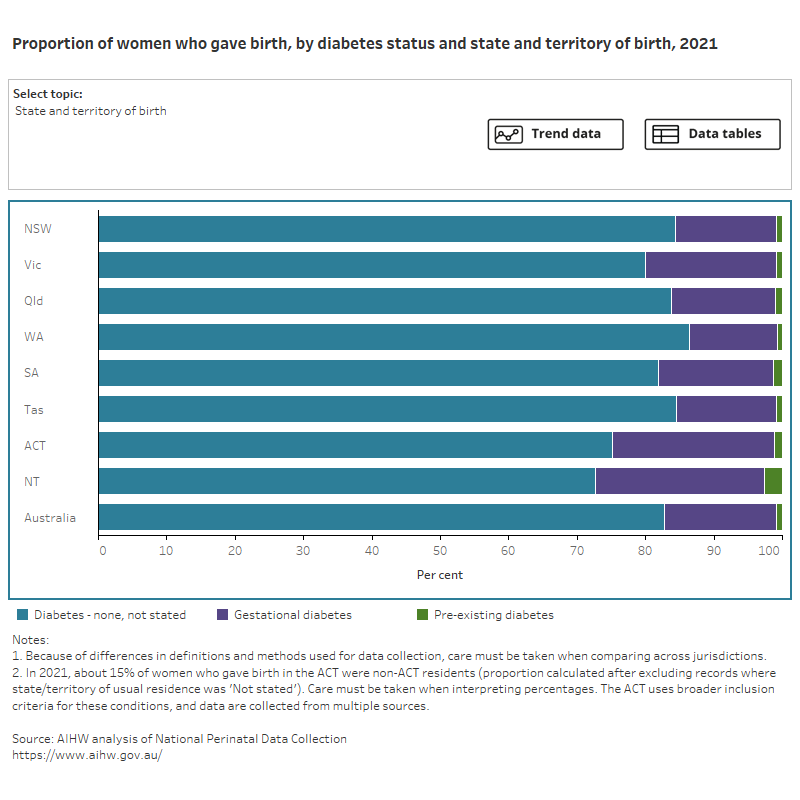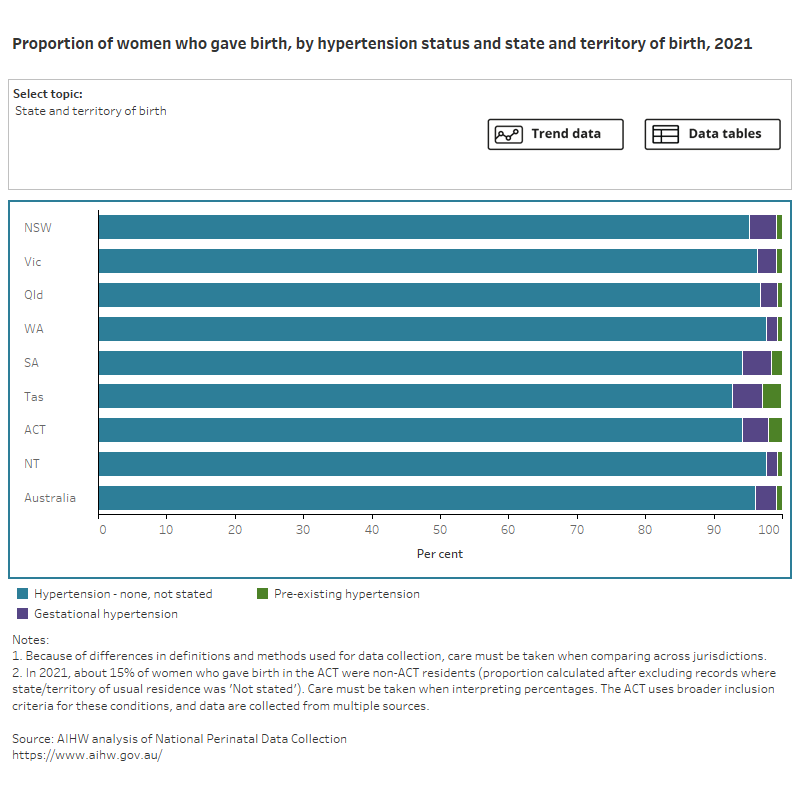Maternal medical conditions
Diabetes and hypertension (high blood pressure) are significant sources of maternal illness and death. Pregnant women with pre-existing or gestational diabetes or pre-existing or gestational hypertension disorders have increased risk of developing adverse outcomes in pregnancy.
Note that data collection methods for diabetes and hypertension vary across states and territories, and trend data exclude Victoria.
Diabetes
Diabetes affecting pregnancy can be pre-existing (that is, type 1 or type 2) or may arise because of the pregnancy (gestational diabetes) (AIHW 2019). It can have short-term and long-term implications for both mothers and their babies and the type and severity of complications may differ according to type of diabetes experienced in pregnancy (AIHW 2019).
Monitoring diabetes during pregnancy is important as it provides information on the impact of diabetes during pregnancy and its complications, identifies groups at higher risk and assists with the planning, monitoring and provision of services (AIHW 2019).
Since 2014, the proportion of women with gestational diabetes has been increasing (8.3% in 2014 compared with 16.3% in 2021).
Figure 1 presents data on the diabetes status of women who gave birth, by selected maternal characteristics, for 2021. Select the trend button to see how data has changed over an 8-year period.
Figure 1: Proportion of women who gave birth, by diabetes status and selected topic
Bar chart shows diabetes status of women by selected topics and a line graph shows topic trends between 2014 and 2021.

In 2021, mothers aged 40 or more (24%) and women who were born overseas (21%) had the highest proportions of gestational diabetes, and First Nations mothers (2.2%) and women with a parity of 4 or more (2.1%) had the highest proportions of pre-existing diabetes.
For more information on diabetes during pregnancy see National Perinatal Data Collection annual update data table 2.46.
Hypertension
Hypertension is a leading cause of illness and death for mothers and babies (Queensland Health 2015). Complications of hypertension that can affect the mother include cerebral injury, liver and kidney failure. Those which can affect the baby include being born pre-term, being small for gestational age and being admitted to the special care nursery (Queensland Health 2015).
The proportion of women with gestational hypertension has remained stable at about 3–4% since 2014 (3.2% in 2021).
Figure 2 presents data on the hypertension status of women who gave birth, by selected maternal characteristics, for 2021. Select the trend button to see how data has changed over an 8-year period.
Figure 2: Proportion of women who gave birth, by hypertension status and selected topic
Bar chart shows hypertension status by selected topics and a line graph shows topic trends between 2014 and 2021.

In 2021, mothers aged 40 or more (4%) and first-time mothers had the highest proportions of gestational hypertension (2.9%). Mothers aged 40 or more (2.5%) and women with a parity of 4 or more (1.7%) had the highest proportions of pre-existing hypertension.
For more information on hypertension during pregnancy see National Perinatal Data Collection annual update data table 2.46.
References
AIHW (Australian Institute of Health and Welfare) (2019) Diabetes in pregnancy 2014–2015, AIHW, Australian Government, accessed 17 June 2022.
Queensland Health (2021) Hypertension and pregnancy, document number MN15.13-V8-R26, Queensland Health, Queensland Government, accessed 31 May 2022.


